Woodblock Prints in the Ukiyo-e Style
1/11
There's no tags or description
Looks like no tags are added yet.
Name | Mastery | Learn | Test | Matching | Spaced |
|---|
No study sessions yet.
12 Terms
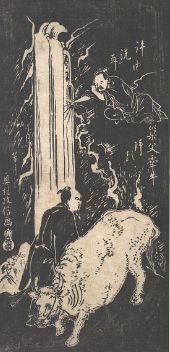
Xu You and Chao Fu
Okumura Masanobu, 18th century (Edo), white-line woodblock print
A straightforward and classical telling of the story in the title, Xu You washing his ears out in a waterfall, Chao Fu turning his ox around from the water
imitates the ‘rubbing’ technique, used for renditions of classical inscriptions
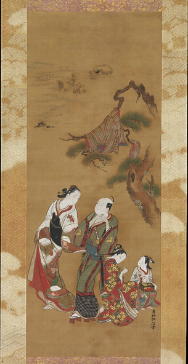
Yukihira and Two Brinemaidens at Suma
Okumura Masanobu, 18th century (Edo), Hanging scroll
Masanobu is an ukiyo-e innovator, depicting a classic tale (Matsukaze and Murasame sisters) in the style of the ‘floating world’ of Edo’s pleasure quarter
The sisters’ lover, Yukihira, is portrayed in a flashy robe, patterned with bamboo blinds, and courtier’s cap crests
shows the fantasy of the Edo townsman as a royal lover
A striped jacket and hat are on the tree behind them, recalling a fabled pine at Suma where Yukihira left them as parting gifts
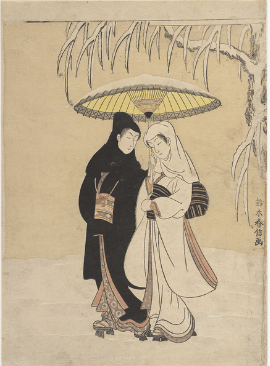
Lovers Walking in the Snow (Crow and Heron)
Suzuki Harunobu, 1764-72 (Edo), Woodblock print
Shows two lovers walking in the snow, perhaps suggesting a michiyuki, a love suicide
in an ai ai gasa pose, AKA sharing of an umbrella and love
Harunobu is the originator of the polychrome print, and his expertise is shown here in the contrast between black and white and the polychrome details
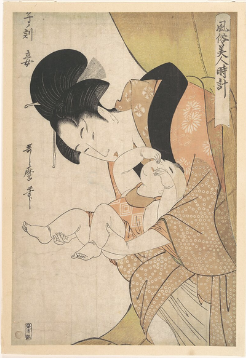
Hour of the Rat: Mistress, from the series Women’s Daily Customs
Kitagawa Utamaro, 1790 (Edo), Woodblock print
Utamaro is one of the most famous artists in the bijin genre, portraying beautiful women, and mothers and children
the everyday nature of this subject shows the increased interest in the everyday person/the individual in the mid to late Edo period
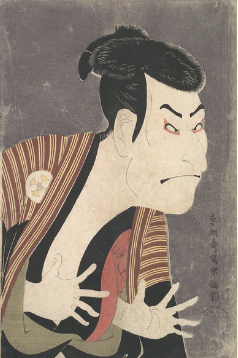
Kabuki Actor Otani Oniji III as Yakko Edobei
Toshusai Sharaku, 1794 (Edo), Woodblock print
the actor is depicted here in the role of a samurai’s manservant, from the play The Colored Reins of a Loving Wife
the pose and expression shows his nature as a wicked henchman
Sharaku was able to capture the quality of the Kabuki character, but also the actor who portrayed him
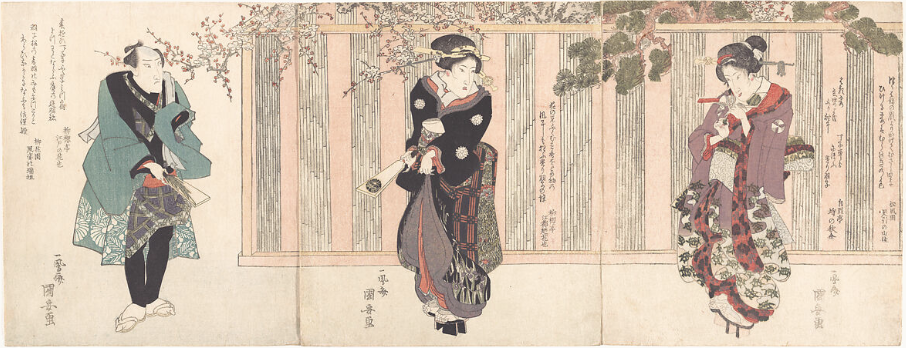
Three Kabuki Actors Playing Hanetsuki
Utagawa Kuniyasu, 1823 (Edo), Woodblock print Triptych
Compared to his teacher, Utagawa Toyokuni, Kuniyasu had more angular lines and facial details
this print was made in honor of the New Year, the actors playing a badminton esque game called hanetsuki, a traditional New Year’s game
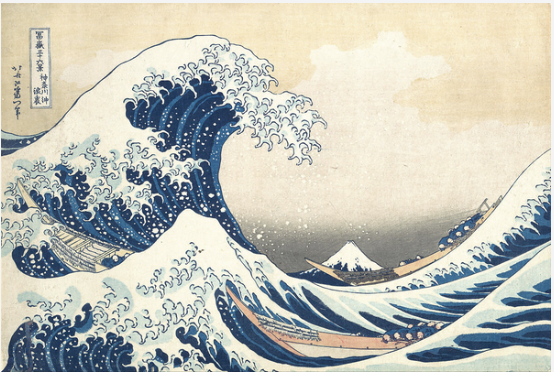
Under the Wave off Kanagawa, AKA The Great Wave
Katushika Hokusai, 1830-32 (Edo), Woodblock print
Part of the series Thirty-six Views of Mount Fuji (Fugako Sanjurokkei)
Later said to have inspired Debussy’s La Mer (The Sea) and Rilke’s Der Berg (The Mountain)
Hokusai played with perspective, making mount Fuji seem tiny, and would later become famous for his landscapes in indigo and imported Prussian blue
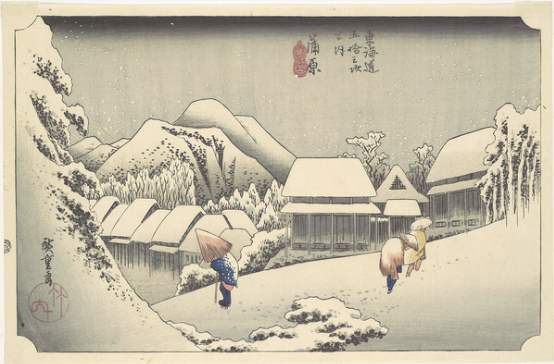
Evening Snow at Kanbara, from the series Fifty Three Stations of the Tokaido
Utagawa Hiroshige, 1833-34 (Edo), Woodblock print
This scene is an imaginary one, as it was made during the summertime, and this area of Japan, Kanbara, does not get much snow anyway
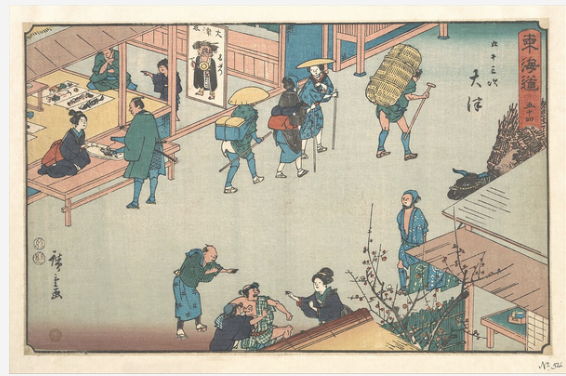
Otsu
Utagawa Hiroshige, 1840 (Edo), Woodblock print
Depicts a highway called the Tokaido, which stretched about 290 miles from Nihonbashi (center of Edo), to the Great Sanjo Bridge in Kyoto
lots of great landscapes, interspersed with human activity along the path, this print shows travelers on a busy street, from a bird’s eye perspective view featured in East Asia
Comes from a series called Fifty three Stations of the Tokaido, published in 1848-49, popularly known as Reisho Tokaido, from the archaic calligraphy in each print
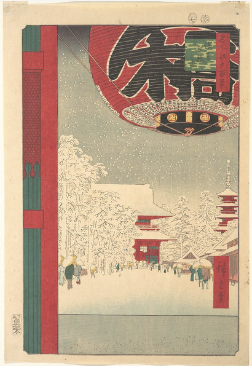
Kinryusan Temple at Asakusa, from the series One Hundred Famous Views of Edo
Utagawa Hiroshige, 1856, Woodblock print
Depicts the most famous temple at Asakusa, Kinryūsan Sensōji dedicated to the boddhisattva Kannon
The auspicious color scheme of the red building against the white snow creates a celebratory mood
‘painted by Hiroshige’ is signed in the lower right corner
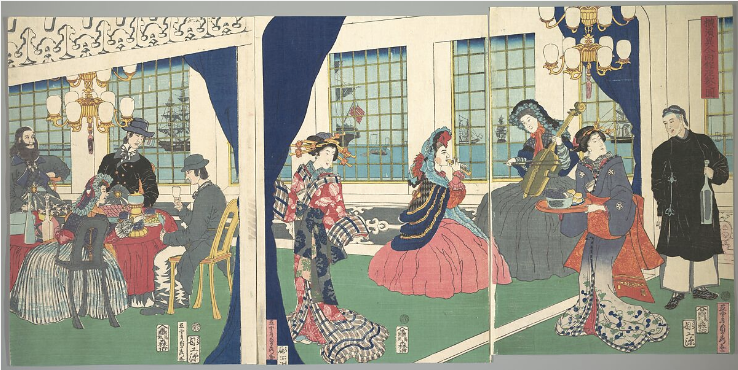
Foreigners in the Drawing Room of Foreign Merchant’s House in Yokohama
Utagawa (Gountei) Sadahide, 1861 (Edo), Woodblock print triptych
Shows an imaginary scene, relating to the surprise of American Matthew Perry (1794-1858) arriving in Tokyo in 1853, to the surprise of the Japanese people who had been isolated since the national seclusion act of 1639, over 200 years
After Perry’s visit, the doors opened to the West, the ‘modern age’ rushing into Japan
Foreigners visiting from England, the Netherlands, France, Russia and the United States (the five nations) were restricted to living in Yokohama, a port city on Tokyo Bay
their appearance was subjected to intense scrutiny, and became a trend for ‘Yokohama prints', prints depicting non East-Asia foreigners
In this scene, a Western merchant is with his family in a European-style house, with a western style ship in the background through the window
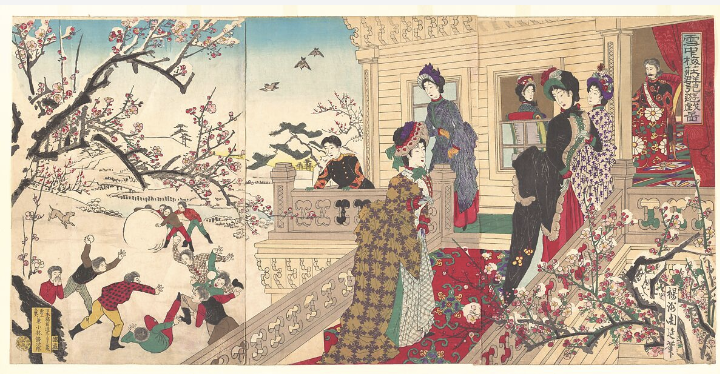
Children Playing in the Snow under Plum Trees in Bloom
Yoshu (Hashimoto) Chikanobu, 1887 (Meiji), Woodblock print triptych
The prince encourages his playmates to play in the snow, but he sits alone, even his military costume, a replica of his father’s, setting him apart
It’s known that this prince (Prince Haru, future Taishō emperor) was plagued with illness